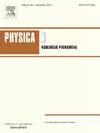Bifurcations patterns and heat transmissions in couple-stress fluid layer with isothermal rigid boundaries
IF 2.7
3区 数学
Q1 MATHEMATICS, APPLIED
引用次数: 0
Abstract
In this work, we investigate the dynamical patterns of thermo-convective loops in a horizontal shallow layer of couple-stress fluid confined between isothermal rigid boundaries and heated from beneath. The novelty of this study lies in examining the influences of couple-stresses on the dynamical patterns of fluid convection in the presence of rigid boundaries. Both the linear and non-linear stability analyses are performed. It is found that the critical Rayleigh number for the onset of convection increases significantly with the couple-stress parameter (). Using low-order Galerkin approximations within the framework of non-linear stability analysis, a three-dimensional, non-linear, dissipative system governed by four control parameters is derived. Studies reveal that the transitions to the stationary and oscillatory convections (through pitchfork and Hopf bifurcations, respectively) detain with the enhancement of , consistent with observations for free-isothermal boundaries. Notably, a striking outcome of this research is that, unlike the stress-free case, the subcritical Hopf bifurcation evolves to supercritical one as exceeds a critical threshold of approximately 0.1022708, and it fundamentally alters the flow dynamics. At this threshold value of the parameter , the system experiences a codimension-2 Bautin bifurcation, which is not likely to appear in the classical Lorenz system for realistic parameters values. Furthermore, the mode of heat transport stabilizes from convection to conduction with increasing . Variations in the stream function and isotherm function with respect to are analyzed and depicted. Additionally, the effect of couple-stresses on the chaotic regime at a high reduced normalized Rayleigh number () exhibits intermittent behavior, and chaos is entirely suppressed for a suitable value of , indicating the stabilization of the system.
具有等温刚性边界的耦合应力流体层的分岔模式和传热
在这项工作中,我们研究了在等温刚性边界和从下面加热的耦合应力流体的水平浅层中热对流环路的动力学模式。本研究的新颖之处在于考察了在刚性边界存在下,耦合应力对流体对流动力学模式的影响。进行了线性和非线性稳定性分析。发现对流开始的临界瑞利数随着耦合应力参数(C)的增加而显著增加。在非线性稳定性分析的框架内,利用低阶伽辽金近似,导出了一个由四个控制参数控制的三维非线性耗散系统。研究表明,过渡到平稳和振荡对流(分别通过pitchfork和Hopf分岔)随着C的增强而持续,这与自由等温边界的观察结果一致。值得注意的是,本研究的一个显著结果是,与无应力情况不同,当C超过约0.1022708的临界阈值时,亚临界Hopf分岔演变为超临界分岔,并从根本上改变了流动动力学。在参数C的这个阈值处,系统经历了一个余维-2鲍丁分岔,这在经典洛伦兹系统中不太可能出现。此外,随着C的增加,热传递方式从对流到传导趋于稳定,分析并描述了流函数和等温线函数随C的变化。此外,在高归一化瑞利数(r1=200)时,耦合应力对混沌状态的影响表现出间歇性行为,并且在适当的C值下混沌被完全抑制,表明系统稳定。
本文章由计算机程序翻译,如有差异,请以英文原文为准。
求助全文
约1分钟内获得全文
求助全文
来源期刊

Physica D: Nonlinear Phenomena
物理-物理:数学物理
CiteScore
7.30
自引率
7.50%
发文量
213
审稿时长
65 days
期刊介绍:
Physica D (Nonlinear Phenomena) publishes research and review articles reporting on experimental and theoretical works, techniques and ideas that advance the understanding of nonlinear phenomena. Topics encompass wave motion in physical, chemical and biological systems; physical or biological phenomena governed by nonlinear field equations, including hydrodynamics and turbulence; pattern formation and cooperative phenomena; instability, bifurcations, chaos, and space-time disorder; integrable/Hamiltonian systems; asymptotic analysis and, more generally, mathematical methods for nonlinear systems.
 求助内容:
求助内容: 应助结果提醒方式:
应助结果提醒方式:


